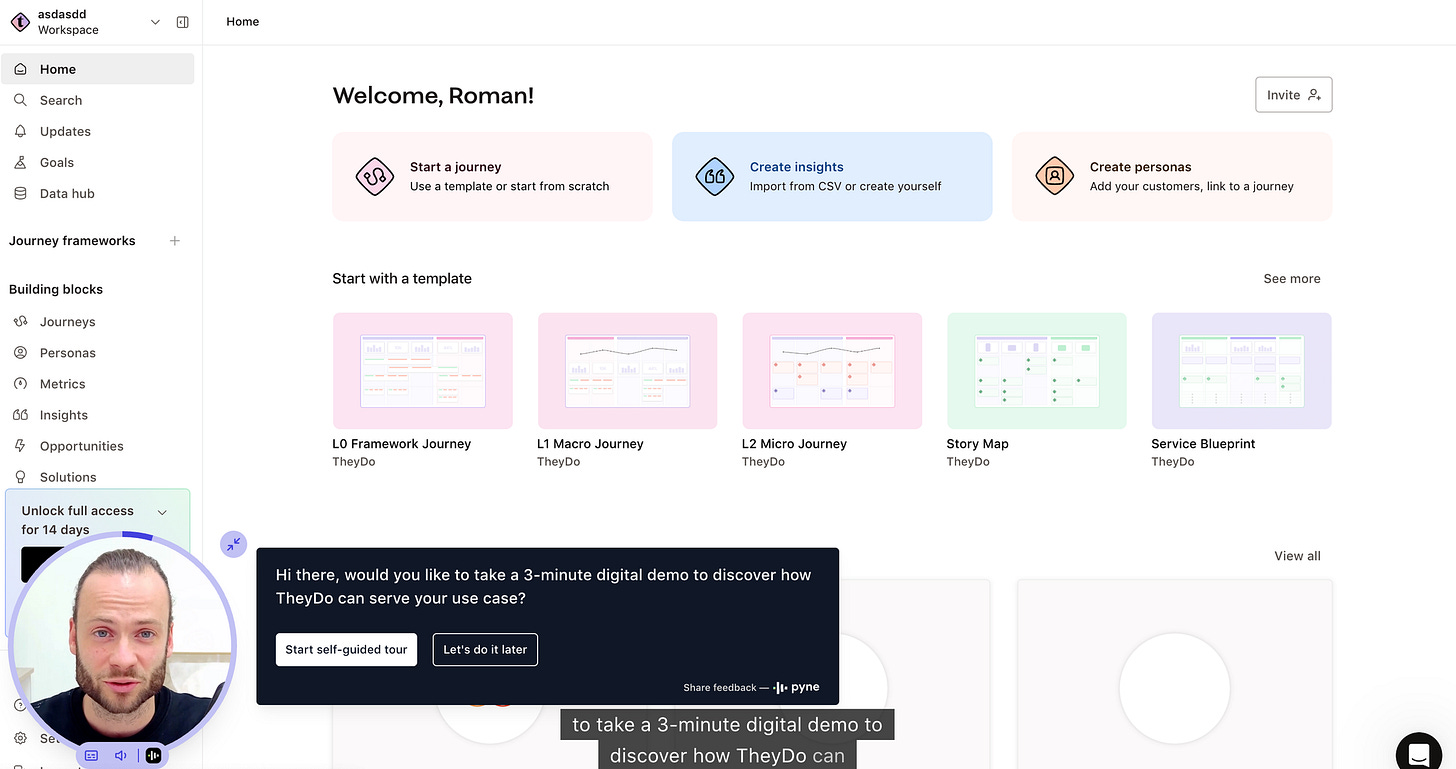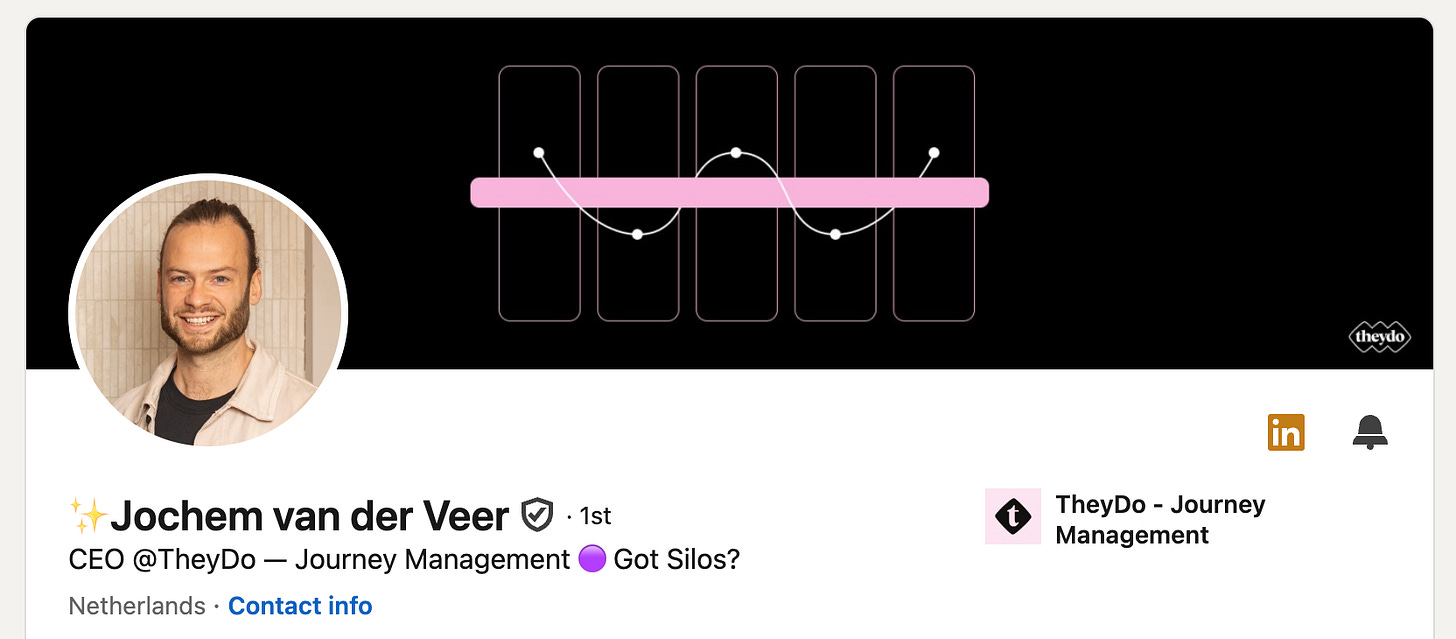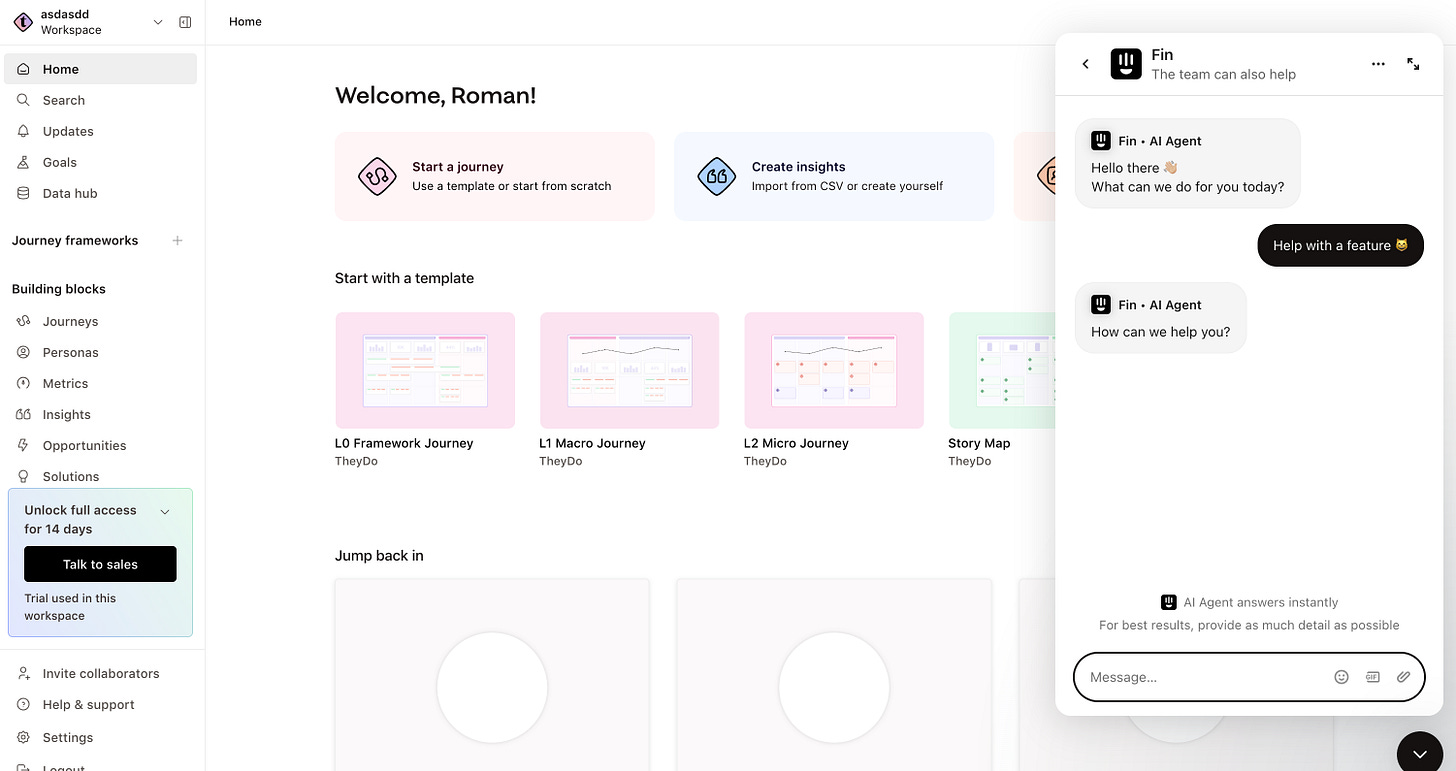How an AI-Powered “User Onboarding Agent” More Than Doubled our Activation Rate
A behind-the-scenes look at how TheyDo replaced manual onboarding with a “CEO AI avatar” — and turned their onboarding into a true growth engine.
Hello everyone 👋 I’m Kate Syuma, and welcome to Growthmates.news — the newsletter where we explore inspiring and practical growth stories from products we love. Join the community of 5,900+ Product, Design, and Growth people from companies like Amplitude, Intercom, Miro, Atlassian, Grammarly, Framer, and more.
After reviewing hundreds of onboarding flows, one truth kept staring me in the face: most onboarding lacks humanity 🖤.
But last year, I saw a glimpse of a better way. I came across Pyne.ai and advised their team on their early direction, inspired by the idea that onboarding could feel like real hand-holding… but scaled by AI. The team has come a long way building the solution, and finally, I saw it applied in action with real impact.
That’s when I met Jochem van der Veer, CEO of TheyDo. After our podcast chat, I learned how TheyDo used Pyne to completely reimagine their onboarding — and saw real activation lift as a result.
This post is about the real application of AI in onboarding — and how a fast-growing product team made it actually work.
Introducing Jochem van der Veer (Founder of TheyDo).
Jochem and the team at TheyDo are on a wicked mission to make customer-centricity common at the Enterprise. They’ve helped thousands of teams get business decision-making rooted in customer journeys. But as their Journey AI is contextualizing unstructured data for the Enterprise, every person signing up, also starts with getting their data into a customer journey context.
It’s the perfect case for AI onboarding at an enterprise scale.
What follows is Jochem’s firsthand story of how TheyDo moved from clunky click-tours and champion-only onboarding to an experience that scales to entire teams — and actually drives activation.
What we cover in this post:
Why TheyDo’s original onboarding setup failed — and what wasn’t working;
How they identified their true “Aha!” moment (and made it discoverable);
The exact AI onboarding system they built with Pyne — step by step;
The measurable results they saw (including 2x+ activation rate);
A simple 4-step framework to build your own AI onboarding agent.
Now, let’s enjoy a breathtaking story from Jochem, CEO of TheyDo.com 👇
We’ve gotten so much praise for our onboarding experience — given the complexity of Journey Management — over the last year and we it’s been a major reason why we were able to grow like we did. But we came from humble beginnings. We imagined PLG was our way, but we couldn’t be more wrong.
I’ll never forget that Friday evening moment — our activation curve stubbornly flat after rolling out another click-tour. I sat there watching users skip every tutorial step and thought, “This can’t be the best we’ve got.” If you’re a product or growth lead drowning in new sign-ups that don’t stick, you know the feeling: even your biggest advocates can’t drag the rest of their team across the finish line. Also, as we scale into an organization we need a lot more people from existing teams to get started with confidence.
At TheyDo, we fixed this by swapping manual hand-holding 1,000s of users a month for an AI-powered “CEO onboarding guide” that lives in-app.
🎯 The results?
Pull up a chair: I’ll walk you through the exact playbook we used.
1. Why our past onboarding experiments failed
“We tried every in-product tour under the sun—and nothing moved the needle.”
Before we landed on what worked, we ran into just about everything that didn’t.
We threw the kitchen sink at activation:
Click-tours in every corner of our UI: annoying, easily skipped, and added little to no user delight.
Chatbots trained on our knowledge base: helpful for FAQs, but not for real guidance.
Video tutorials on YouTube and our website: removed users from the product flow.
We even A/B tested product tours and saw zero uplift in activation.
Despite decent feedback from power users, our onboarding flow hit a wall once wider teams got involved. Champions understood the value — their teammates didn’t. We were stuck between:
Onboarding everyone manually — not scalable.
Letting them figure it out — led to drop-off.
Neither solution worked. Neither drove growth.
2. Our "Aha!" that changed everything
“Users who saw our Opportunity Matrix converted 5 times faster — if only they could find it.”
Then, let’s call it a random Tuesday at 11 AM, a spike in conversions caught my eye: a cohort that converted at 5x the rate that had discovered our AI-generated Opportunity Matrix — a side-by-side comparison of where to focus to improve the customer journey.
But here’s the kicker: almost nobody reached the Matrix without help. Our champions knew the path, but their teammates didn’t.
To get there, users needed to:
Build journey maps;
Uploaded research;
Analyze transcripts with our AI;
And learned some mapping theory.
That realization flipped the script. If your “magic” lives buried three levels deep, no amount of FAQ-answering AI will surface it.
Me and my cofounders were always willing to deep dive with customers to get them to this “point of no return”, but that didn’t scale. Since we were early adopters of AI in our own product, we back then wished there was a way to give every single person the “founder onboarding experience” and decided to experiment with this with a small company called Pyne.
3. Building our User Onboarding AI Agent with Pyne
With Pyne's help, we captured our best human onboarding flows and embedded them in the product as an AI avatar: our own “User Onboarding AI Agent.”
If you want to see it live, just sign up for a trial at TheyDo and you’ll see it.

Step 1 👉 Mapping our own user journey
First, we recreated our ideal flow:
Gather inputs: support tickets, onboarding call transcripts, playbook scripts.
Journey map: let TheyDo’s JourneyAI map every delight and drop-off for us.
In hindsight, our process was intensely hands-on, like guiding someone on a bike for miles. But that effort revealed exactly where users kept getting stuck.
Step 2 👉 Automating the best of human hand-holding
Next, we worked with Pyne to train an AI avatar that:
Delivered scripted micro-lessons — a 5-minute walkthrough in the CEO’s voice.
Used interactive prompts so users could choose their path, go deeper, or explore freely.
It felt personal, not robotic — like having a founder onboard you.
“Listening to my own AI voice and avatar felt odd at first — but watching it guide people through the product made all the difference.”
Step 3 👉 Seamless updates & true differentiation
Because the guide lives in-app:
We update the script — no re-recordings needed.
The tone stays on-brand — always feels like TheyDo.
What used to be a support burden became a growth lever.

4. The proof is in the numbers
Data doesn’t lie. Since launching our AI CEO Guide:
We saw major improvements:
Overall activation rate more than doubled;
More 2nd and 3rd stakeholders fully onboarded — not just the champion.
This last point mattered most. Internal champions no longer had to do the heavy lifting alone. Our guide did it for them.
5. Behavioral insights: Why this works
We didn’t just bolt AI onto a static UI; we tapped into how people think:
Guidance on their terms. Users want to be guided, but not on a salesperson's terms. We enabled “a human experience” without the cost implications and the emotional burden on the person receiving a pitch.
Show & Tell → do-it-yourself loop. Our 42-step demo sees a staggering 59% completion for users that start the demo. That means that all of those users will know whether TheyDo is for them after this session and will be able to advocate if it’s a fit.
Delight drives memory. That first “Hello, I’m your CEO guide” from my (American-accented) avatar surprises and sticks.
💡When you delight people, they remember — and they tell others.
6. 🛠️ Your turn: Build your own “User Onboarding Agent”
Follow these four concrete steps — mirroring exactly what we did at TheyDo — to go from manual hand-holding to an AI-avatar user onboarding guide.
Map your true user journey.
Gather your raw data: export support tickets, call-transcript highlights, in-product feedback.
Visualize the flow: import those assets into TheyDo (or sketch in Figma) and tag every “delighter” and every “drop-off.” (we do this with AI in the TheyDo platform)
Align your teams: share this map with marketing, product, and your onboarding squad so everyone speaks the same language.
Write your “CEO” demo playbook.
Script the ideal play: based on your map, draft a short “executive walkthrough” that calls out each delighter and steers users past every blocker.
Define branch points: “If you click X, jump to section Y,” so no user ever hits a dead end.
Decide on a scaled method for delivery.
Simple products can use tooltips.
More complex ones really benefit form an interactive avatar (we used Pyne).
Iterate & prove impact.
A/B test every element: timing, tone, trigger points.
Measure activation: track how many users hit your key milestone (e.g. Opportunity Matrix) in your CDP or CRM.
Optimize on time-to-value: aim to cut days (or weeks) off your current benchmark.
Five months from now, picture logging in to an activation chart that’s skyrocketed — and remembering this very post as the spark.
Onboarding doesn’t have to be a grind. With the right mix of human insight and AI execution, you can build a self-driving engine that delights your users - and helps you grow with ease.
Too many onboarding flows still feel like checklists — soulless, forgettable, and easy to skip. But it doesn’t have to be that way.
This story proves that AI-powered onboarding doesn’t mean losing the human touch. In fact, when done right, it amplifies it — bringing your best onboarding moments to every user, on their own terms, at scale.
👉 4 ways I can help improve your User Onboarding:
🏃Onboarding Audit: Growth Sprint → For two weeks, I will personally guide your team to fix your holistic Onboarding (from Website to Habit-forming). We will uncover gaps from data and user insights, design an emotional first experience that delights your users and uplifts your Activation rate. (Past clients achieved 15 %+ increase in Activation with my help.)
🎓 User-centric Growth Course → (100$ off with promo “growthmate” 🎁). Bring your growth challenge and turn it into a Growth roadmap from Quick Wins to Big Bets by combining behavioural science and proven growth strategies.
📊 Product-led Growth: Advising Program → Let’s start with Activation and progress to enabling the entire Product-led Growth as a system for your B2B or B2C product. The deepest format of collaborating with me (starts from 3+ months).
📩 Newsletter Collaboration → Want to share a story like this one with a community of almost 6000 product and design people? Send a request to hello@growthmates.club and let’s discuss how I can help.
📕 Resources mentioned:
Pyne.ai — Your AI agent for user onboarding.
TheyDo.com — Journey management for business decision-making.
Growthmates Podcast episode: From Designer to CEO: Building Design-led and Journey-centric Business (Jochem van der Veer, CEO at TheyDo).
If you’re staring at flat activation charts, frustrated by limited resources, I get you. Start small. Map the journey. And let AI do the heavy lifting.
Because onboarding isn’t just the start of the user experience — it is the experience that t. Make it count.
This is all for today, dear readers. If you found this helpful — please share your reaction and leave some comments 💜 It would give a huge support for me to continue creating this!
If you find this newsletter valuable, share it with a friend, and consider subscribing if you haven’t already. There are some discounts available, and maybe you can expense this :)
Connect with Jochem van der Veer (thanks for sharing this story!) and me — Kate Syuma 🙌 Learn more about my work on Growthmates.club 👉
Keep growing!
Kate Syuma & Growthmates.














